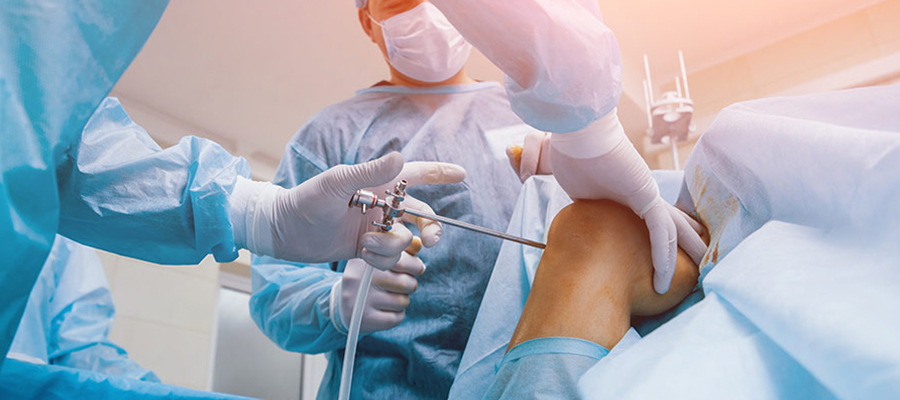
Estimated reading time: 4 minutes and 4 seconds
Knee Arthroscopy Surgery
Comprehensive Knee Arthroscopy Surgery at Aktif International Hospitals
Knee arthroscopy surgery is a minimally invasive procedure used to diagnose and treat a variety of knee joint problems, including torn ligaments, damaged cartilage, and inflamed synovial tissue. This surgical technique involves inserting a small camera (arthroscope) and specialized surgical instruments through small incisions around the knee joint, allowing the surgeon to visualize the internal structures of the knee and perform repairs as needed. At Aktif International Hospitals, we offer comprehensive knee arthroscopy surgery performed by experienced orthopedic surgeons using state-of-the-art technology and advanced techniques.
Frequently Asked Questions
What is knee arthroscopy surgery, and why is it performed?
Knee arthroscopy surgery is a minimally invasive surgical procedure used to diagnose and treat a variety of knee joint problems, including:
- Torn meniscus: Tears in the meniscus, the cartilage cushioning the knee joint, can cause pain, swelling, and limited range of motion.
- ACL or PCL tears: Injuries to the anterior cruciate ligament (ACL) or posterior cruciate ligament (PCL) can cause instability and weakness in the knee joint.
- Damaged cartilage: Cartilage damage, such as chondral defects or osteochondritis dissecans (OCD), can lead to pain, swelling, and loss of function.
- Synovitis: Inflammation of the synovial lining of the knee joint can cause pain, swelling, and stiffness.
Knee arthroscopy allows the surgeon to visualize the inside of the knee joint and perform repairs or corrections as needed, often resulting in faster recovery times and less postoperative pain compared to traditional open surgery.
What are the benefits of knee arthroscopy surgery?
Some of the benefits of knee arthroscopy surgery include:
- Minimally invasive: Knee arthroscopy is a minimally invasive procedure that requires only small incisions, resulting in less tissue damage, scarring, and postoperative pain compared to traditional open surgery.
- Faster recovery: Patients undergoing knee arthroscopy surgery typically experience faster recovery times and return to normal activities sooner than those undergoing open surgery.
- Diagnostic capabilities: In addition to providing treatment, knee arthroscopy allows the surgeon to visualize the internal structures of the knee joint and diagnose any underlying problems accurately.
How is knee arthroscopy surgery performed?
During knee arthroscopy surgery:
- Anesthesia: The patient is placed under general anesthesia or regional anesthesia to ensure comfort and pain control during the procedure.
- Incisions: Small incisions are made around the knee joint, through which the arthroscope and surgical instruments are inserted.
- Visualization: The arthroscope is inserted into the knee joint, allowing the surgeon to visualize the internal structures, such as the ligaments, cartilage, and synovial tissue, on a monitor.
- Treatment: Surgical instruments are used to repair or remove damaged tissue, such as repairing torn ligaments, trimming or repairing torn meniscus, removing loose cartilage or bone fragments, or treating inflamed synovial tissue.
- Closure: After the procedure is complete, the incisions are closed with sutures or adhesive strips, and a sterile dressing is applied.
What is the recovery process after knee arthroscopy surgery?
The recovery process after knee arthroscopy surgery varies depending on the specific procedure performed and the patient’s individual circumstances. However, in general:
- Pain management: Patients may experience mild to moderate pain and discomfort after surgery, which can be managed with pain medications prescribed by the surgeon.
- Physical therapy: Physical therapy exercises and rehabilitation are essential for restoring strength, flexibility, and range of motion to the knee joint and improving overall function.
- Gradual return to activity: Patients typically begin with gentle exercises and activities as tolerated and gradually increase intensity and duration over time under the guidance of their surgeon or physical therapist.
- Follow-up appointments: Follow-up appointments with the surgeon are scheduled to monitor progress, assess healing, and make any necessary adjustments to the treatment plan.
Why choose Aktif International Hospitals for knee arthroscopy surgery?
Aktif International Hospitals is dedicated to providing compassionate, expert care for patients with knee joint problems and their families. Our team of experienced orthopedic surgeons, nurses, and healthcare professionals are committed to delivering safe, effective, and personalized care to achieve the best possible outcomes for our patients.
Trust Aktif International Hospitals for Expert Knee Arthroscopy Surgery
If you or a loved one is experiencing knee joint problems, don’t wait to seek medical attention. Trust Aktif International Hospitals to provide prompt diagnosis, effective treatment, and compassionate support for you and your family. Schedule a consultation with our experienced orthopedic team today to learn more about knee arthroscopy surgery and how we can help you get back to enjoying life with confidence and peace of mind.
Author: E. Ayhan Arpacı


 TR
TR